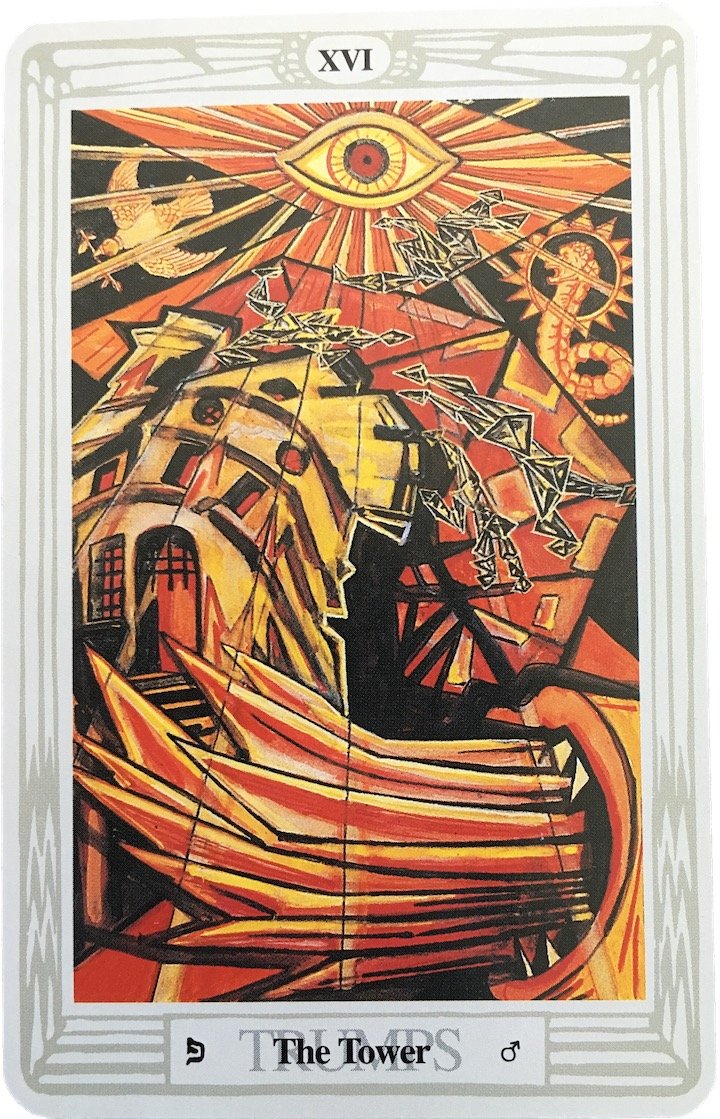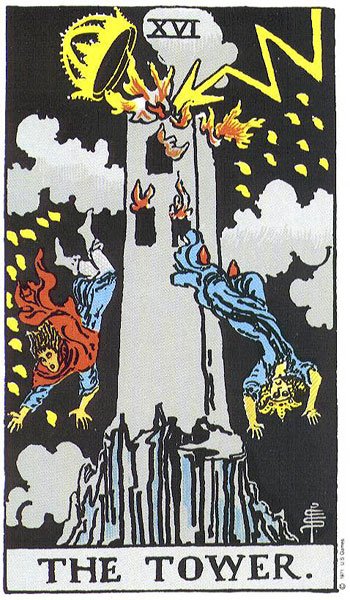THE TOWER : KEY XVI
The Lord of the Hosts of the Mighty
Planetary Trump of Mars
Alchemical Metal of Iron
Hebrew Letter: Pe (Mouth)
Path 27 joining
Sphere 7-Victory and 8-Splendor
Break down the fortress of thine Individual Self, that thy Truth may spring free from the ruins!
Alesiter Crowley
The Book of Thoth
This card is attributed to the letter Peh, which means a mouth; it refers to the planet Mars. In its simplest interpretation it refers to the manifestation of cosmic energy in its grossest form. The picture shows the destruction of existing material by fire. It may be taken as the preface to Atu XX, the Last Judgment, i.e., the Coming of a New Aeon. This being so, it seems to indicate the quintessential quality of the Lord of the Aeon. [See Liber AL III. 3-9; II – 13; 17-18; 23-29; 46; 49-60; 70-72.]
Bellona, scream! Unhood the Hawks! The roar Of Universes crashing into War!
At the bottom part of the card, therefore, is shown the destruction of the old-established Aeon by lightning, flames, engines of war. In the right-hand corner are the jaws of Dis, belching flame at the root of the structure. Falling from the tower are broken figures of the garrison. It will be noticed that they have lost their human shape.
They have become mere geometrical expressions.
This suggests another (and totally different) interpretation of the card. To understand this, it is necessary to refer to the doctrines of Yoga, especially those most widely current in Southern India, where the cult of Shiva, the Destroyer, is paramount. Shiva is represented as dancing upon the bodies of his devotees. To understand this is not easy for most western minds. Briefly, the doctrine is that the ultimate reality (which is Perfection) is Nothingness. Hence all manifestations, however glorious, however delightful, are stains. To obtain perfection, all existing things must be annihilated. The destruction of the garrison may therefore be taken to mean their emancipation from the prison of organized life, which was confining them. It was their unwisdom to cling to it.
The above should make it clear that magical symbols must always be understood in a double sense, each contradictory of the other. These ideas blend naturally with the higher and deeper significance of the card.
There is a direct reference to this card in the Book of the Law. In Chapter I, verse 57, the goddess Nuith speaks: “Invoke me under my stars! Love is the law, love under will. Nor let the fools mistake love; for there are love and love. There is the dove, and there is the serpent. Choose ye well! He, my prophet, hath chosen, knowing the law of the fortress, and the great mystery of the House of God”. [For this reason the ancient title, today not very intelligible, has been retained. Otherwise, it might have been called War.]
The dominating feature of this card is the Eye of Horus. This is also the Eye of Shiva, on the opening of which, according to the legend of this cult, the Universe is destroyed.
Besides this, there is a special technical magical meaning, which is explained openly only to initiates of the Eleventh degree of the O.T.O.; a grade so secret that it is not even listed in the official documents. It is not even to be understood by study of the Eye in Atu XV. Perhaps it is lawful to mention that the Arab sages and the Persian poets have written, not always guardedly, on the subject.
Bathed in the effulgence of this Eye (which now assumes even a third sense, that indicated in Atu XV) are the Dove bearing an olive branch and the Serpent: as in the above quotation. The Serpent is portrayed as the Lion-Serpent Xnoubis or Abraxas. These represent the two forms of desire; what Schopenhauer would have called the Will to Live and the Will to Die. They represent the feminine and masculine impulses; the nobility of the latter is possibly based upon recognition of the futility of the former. This is perhaps why the renunciation of love in all the ordinary senses of the word has been so constantly announced as the first step towards initiation. This is an unnecessarily rigid view. This Trump is not the only card in the Pack, nor are the “will to live” and the “will to die” incompatible. This becomes clear as soon as life and death are understood (See Atu XIII) as phases of a single manifestation of energy.


Joan Bunning
The Tower is an unsettling card. Fire, lightning, falling on jagged rocks – definitely looks like trouble! Card 16 will not be welcomed by those who dislike change. It represents a sudden, dramatic upheaval or reversal in fortune. Usually change is gradual, giving us time to adapt, but sometimes it is quick and explosive. This is the action of the Tower.
In films, the hero sometimes slaps someone who is groggy or babbling. Having tried everything else, he finally resorts to a sharp sting to snap him out of it. Sudden crises are life’s way of telling you to wake up. Something’s wrong, and you’re not responding. Are you too full of pride? Expect a blow to your ego. Are you holding back your anger? Expect the dam to burst. Are you stuck in a rut? Expect a surprise.
How you respond to the Tower’s change makes all the difference in how uncomfortable the experience will be. Recognize that the disruption occurred because it was needed. Perhaps embracing the change is too much to ask, but try to find the positive in it. In fact, you may feel tremendous release that you have finally been forced in a new direction. You may have a burst of insight about your situation and reach a new level of understanding about it.
THE TOWER’S ACTIONS
GOING THROUGH SUDDEN CHANGE
experiencing upheaval
having plans disrupted
being surprised
undergoing a crisis
having routines shaken up
being in chaos
RELEASING
exploding
having an emotional outburst
erupting in anger
crashing through ego defenses
breaking through pretense
letting everything go
FALLING DOWN
being humbled
experiencing a crash
toppling from the heights
having a downturn in fortune
suffering a blow to the ego
HAVING A REVELATION
suddenly realizing the truth
exposing what was hidden
having a burst of insight
seeing through illusions
getting the answer
seeing everything in a flash
THE TOWER’S ROLE IN THE FOOL’S JOURNEY
How can the Fool free himself from the Devil? Can he root out his influence? The Fool may only find release through the sudden change represented by the Tower (16). The Tower is the ego fortress each of us has built around his beautiful inner core. Gray, cold and rock-hard, this fortress seems to protect but is really a prison.
Sometimes only a monumental crisis can generate enough power to smash the walls of the Tower. On Card 16 we see an enlightening bolt striking this building. It has ejected the occupants who seem to be tumbling to their deaths. The crown indicates they were once proud rulers; now they are humbled by a force stronger than they.
The Fool may need such a severe shakeup if he is to free himself, but the resulting revelation makes the painful experience worthwhile. The dark despair is blasted away in an instant, and the light of truth is free to shine down.
A.E. Waite
The Pictorial Key to the Tarot
Occult explanations attached to this card are meagre and mostly disconcerting. It is idle to indicate that it depicts min in all its aspects, because it bears this evidence on the surface. It is said further that it contains the first allusion to a material building, but I do not conceive that the Tower is more or less material than the pillars which we have met with in three previous cases. I see nothing to warrant Papus in supposing that it is literally the fall of Adam, but there is more in favour of his alternative–that it signifies the materialization of the spiritual word. The bibliographer Christian imagines that it is the downfall of the mind, seeking to penetrate the mystery of God. I agree rather with Grand Orient that it is the ruin of the House of We, when evil has prevailed therein, and above all that it is the rending of a House of Doctrine. I understand that the reference is, however, to a House of Falsehood. It illustrates also in the most comprehensive way the old truth that “except the Lord build the house, they labour in vain that build it.”
There is a sense in which the catastrophe is a reflection from the previous card, but not on the side of the symbolism which I have tried to indicate therein. It is more correctly a question of analogy; one is concerned with the fall into the material and animal state, while the other signifies destruction on the intellectual side. The Tower has been spoken of as the chastisement of pride and the intellect overwhelmed in the attempt to penetrate the Mystery of God; but in neither case do these explanations account for the two persons who are the living sufferers. The one is the literal word made void and the other its false interpretation. In yet a deeper sense, it may signify also the end of a dispensation, but there is no possibility here for the consideration of this involved question.


